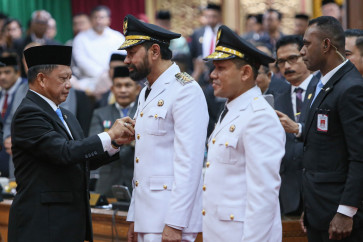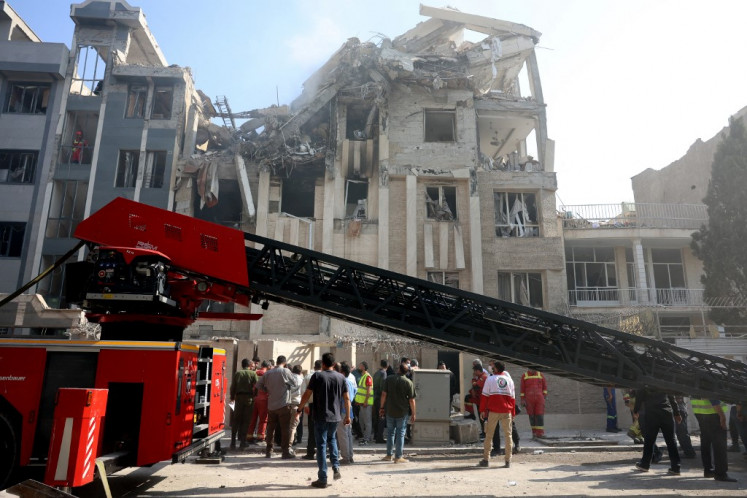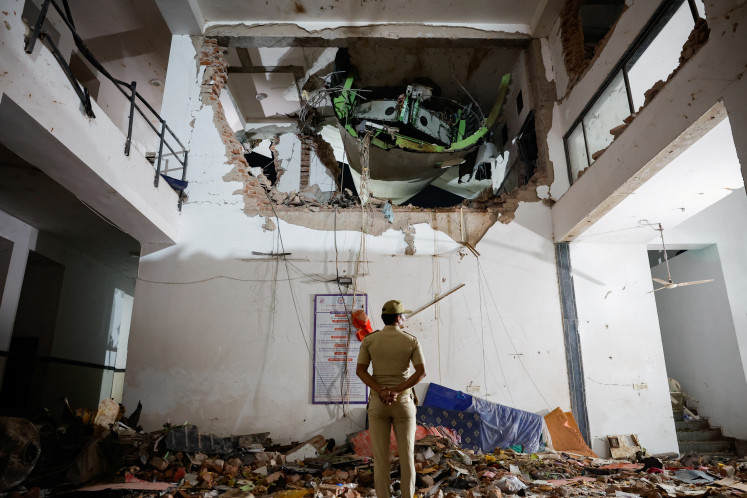Scrambling for a slice of the pyramid
Prayer time: Servants from the Palace pray in the yard of the Surakarta Kasunanan Palace before escorting a pair of pyramid offerings to the Agung Mosque
Change text size
Gift Premium Articles
to Anyone

P
span class="caption" style="width: 378px;">Prayer time: Servants from the Palace pray in the yard of the Surakarta Kasunanan Palace before escorting a pair of pyramid offerings to the Agung Mosque.
There is always something to celebrate in Javanese culture. After the holy month of Ramadan, usually comes Syawalan, the 10th month of the Arabic calendar, which is accompanied by a number of rituals and ceremonies.
In the Kasunanan Palace in Surakarta, Central Java, for instance, the Syawalan tradition goes by the name Grebeg Syawal, and consists of palace officials giving the people of Surakarta two pyramids.
The two pyramids consists of offerings arranged into a cone and shaped like a mountain, which include vegetables and food. One of the pyramids represents the male, the other, the female.
The male pyramid, which is usually made of vegetables, fruits and agricultural products symbolizes prosperity, while the female one is made of rengginang (crisp cracker snacks) made from glutinous rice, and evokes tranquility.
According to the deputy of Pangangeng Sasono Wilopo, Kanjeng Pangeran (KP) Winarno Kusumo, the pair of pyramids is a form of thanksgiving for Hadiningrat Surakarta Kasunanan and its people who fasted for one month. The gift also highlights the Sultan’s concern for his people.
“Apart from this, the ritual also shows the Palace’s gratitude to God, because God has protected His Majesty Paku Buwono XIII and his people,” he said.
For this year’s Grebeg Syawal procession, which was held on Sept. 11, the two pyramid offerings were removed from the yard of the Surakarta Kasunanan Palace.

Earlier that day, all servants and families living in the palace prayed. At around 10 a.m., the Wirabraja
soldiers in charge of clearing the way started walking, followed by drummers.
The families, servants, community members and palace soldiers escorted the pyramids past the Siti Hinggil meeting hall to the Solo Agung Mosque, covering a distance of about 500 meters.
Agung Mosque’s yard was packed with hundreds of residents who had been waiting for the arrival of the procession. They lined up along the road to the mosque to receive the ngalap blessing, and seek blessing from Surakarta Kasunanan Palace.
During the next procession, the female pyramid was taken back to the palace, while the male pyramid was taken out of the mosque.
But before the pyramid was taken away from the mosque’s yard, hundreds of residents rushed to the offering. They jostled, pushed and fought each other to get the pyramid offerings.
Why? Because people believe that anyone who receives a portion of these offerings will be blessed. So it’s no surprise that many were willing to squeeze, fall and get trampled by others just to get a part of this pyramid.

People who were successful in grabbing offerings from the pyramid often just walked away with pieces of snacks, cabbage leaves, pieces of carrots and tomatoes that had been damaged because they’d been crushed. But whatever they managed to get their hands on, they brought home a part of the pyramid they’d received.
The idea of scrambling, or ngrayah, shows that to achieve a goal, humans have to fight.
“In fact what they were fighting for was not a form of merchandise, but a blessing which they have long believed will come through the offerings they can get hold of,” said Winarno.
But more than that, said Winarno, the scramble for the pyramid, known as the Grebeg ceremony, can also be interpreted as a symbol of communication between the Sultan and his people.
It means the Sultan pays very close attention to his people, as can be seen by his willingness to provide a number of agricultural produce to them.

The history of Grebeg cannot be separated from the Wali Songo ( the Nine Saints) spreading Islam, through cultural means, because culture and the arts were well developed at the time.
One of the most influential saints, Sunan Kalijaga, spread his faith through art and culture.
It is believed that Sunan Kalijaga spread Islam by playing gamelan in the yard of the Agung Mosque.
Residents gathered to watch, while Sunan Kalijaga preached and taught the principles of Islam.
During the month of Ramadan, Islamic teachings used to be combined with art, entertainment and local culture. Ramadan climaxed with gifts consisting of agricultural produce.
According to the Javanese, Grebeg follows the actions of all nine Islamic saints. It also contains four meanings: width, dissolving, overflowing and whitewash.
Width refers to broadness; dissolving to sins or mistakes that have been forgiven; overflowing includes giving blessing more frequently; and whitewash means a cheerful face.
As a result, Grebeg Syawal entails finding happiness after all sins have been forgiven and a return to a pure and “clean” soul.
This tradition remains strong and well entrenched in society so it’s not surprising that many districts still celebrate the Syawalan tradition with festivities.
— Photos by Ganug Nugroho Adi









